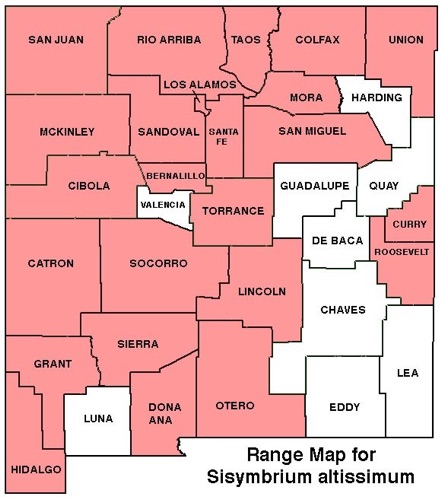WILDFLOWERS OF NEW MEXICO

Blooming in the summer with small, yellow to creamy-white flowers, this weedy, invasive reaches 12–20 inches tall and often has tangled upper branching. It varies from nearly hairless to having conspicuous hairs on the leaves and branches. Note the 4 small petals form a cross pattern, the lower leaves have broad lobes and upper leaves have narrow, linear lobes, and the fruit capsules are about the same diameter as their stalks (pedicels). Also called tall hedge mustard.
FLOWER: March–September. Compact, branching clusters have yellow to creamy flowers with short petals 1/4–3/8 inch long (6–10 mm) in a cross shape; flowering stem elongates as seed capsules (siliques) mature. Outer 2 sepals have horn-like tips. Capsules are a narrow, cylindrical pod 2–4 inches long (5–10 cm), on spreading stalks (pedicels) 1/4–3/8 inch long (6–10 mm), and about as wide as the pod, and angling outward and upward.
LEAVES: Basal with stalks (petioles) and deeply pinnately lobed with 5–8 pairs of pointed, toothed segments; blades 2–6 inches long (5–15 cm) and often have purplish stalks. Stem leaves alternate, reduced in size upward with lobes becoming narrow, linear.
HABITAT: Sandy, loamy, rocky soils of fields, pastures, roadsides, disturbed areas; desert grasslands and scrub, pinyon-juniper, ponderosa woodlands, prairies and plains.
ELEVATION: 4,200–8,900 feet.
RANGE: Widespread, naturalized throughout West and across Great Lake and Great Plains states into New England.
SIMILAR SPECIES: London rocket, S. irio, nearly statewide, blooms in the spring and has yellow flowers, mostly hairless stems and leaves, similarly shaped stem and basal leaves, pedicels thinner than the pods, and upper pods that overtop the flowers. Flixweed, Descurainia sofia, also with long cylindric fruiting capsules, has leaves with fern-like divisions.
NM COUNTIES: Nearly statewide except SE plains in low- to mid-elevation, disturbed areas: Bernalillo, Catron, Cibola, Colfax, Curry Dona Ana, Grant, Hidalgo, Lincoln, Los Alamos, McKinley, Mora, Otero, Rio Arriba, Roosevelt, San Juan, San Miguel, Sandoval, Santa Fe, Sierra, Socorro, Taos, Torrance, Union.









TALL TUMBLE MUSTARD
SISYMBRIUM ALTISSIMUM
Mustard Family, Brassicaceae
Annual herb, introduced, invasive









THE CONTENTS OF THIS WEBSITE ARE COPYRIGHTED AND CANNOT BE USED
WITHOUT PERMISSION OF GEORGE OXFORD MILLER
















EMAIL ME









The 4 rounded petals (upper arrow) are in a cross or X pattern. The outer 2 sepals have horn-like tips (lower arrow).

Leaves and stems vary from hairless to having conspicuous hairs.



























Lower leaves are lined with toothed lobes, often with purplish stems (petioles).
Upper leaves have narrow, linear to filament-like lobes.
Stems often branch into a tangled array.


















The fruiting capsule is long and thin (upper arrow). The pedicel (lower arrow) is stout and as thick as the capsule.












Basal leaves, often with purplish stalks, form a loose, rosette-like cluster.







